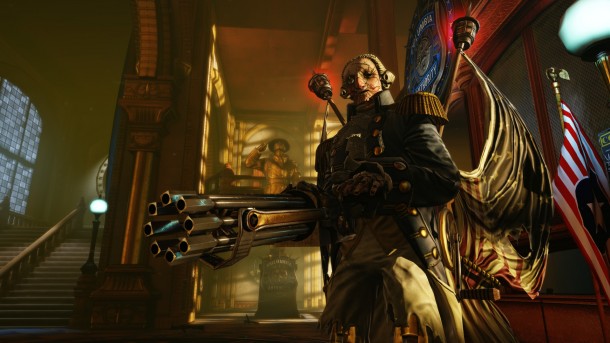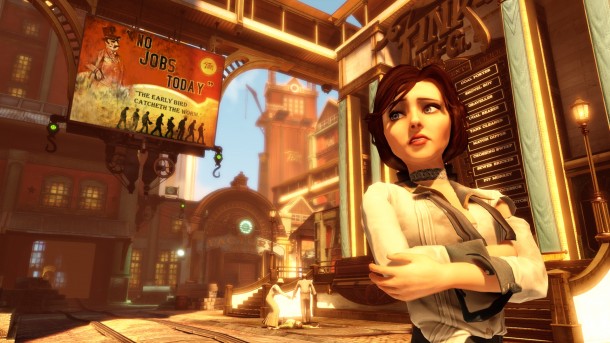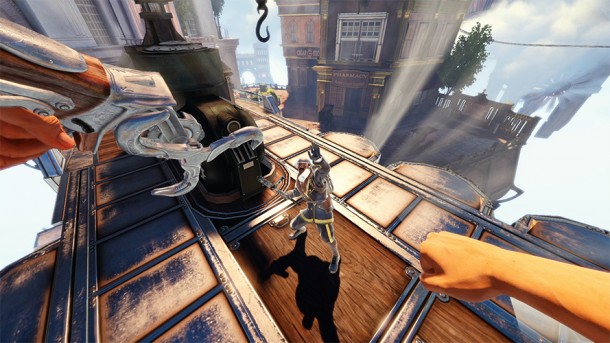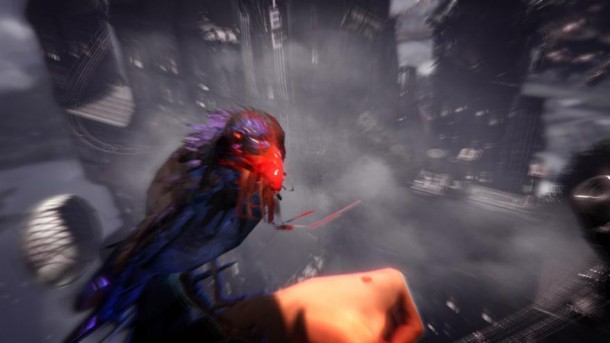One of the most popular buzz words in contemporary games writing has been the word “experience.” The use of the word has become so popular that “game” and “experience” are now synonymous with one another — and rightfully so. When you play a game, visual and audio cues excite certain feelings within you. But I have to go one further and say that the most important experience is the type that teaches you something.
BioShock Infinite is important because of what it teaches us about setting and how powerful it can be as both a narrative tool and a gameplay mechanic. Irrational Games’ grasp of this concept is masterful as Columbia is practically a character in and of itself — a living, breathing entity and constant source of stimuli.
Infinite’s two other main characters are Booker DeWitt and Elizabeth. DeWitt is a man with a blotchy past who has recently found himself with some insurmountable debt. He’s found himself working for people who have offered to pay off his debt. In exchange, he must venture to Columbia, a flying city in the sky, and bring Elizabeth to his current employers.
Upon reaching Columbia, he finds that Elizabeth is held captive for all of her life by Columbia’s top political figure. The compassionate and curious Elizabeth is the perfect foil to DeWitt’s brash personality. Together, they set out to escape Columbia with the usual mind-bending twists and turns that one would expect from Ken Levine and Irrational Games.
Irrational has somehow found a way to exponentially capitalize on their ability to build a living environment. There was a time when I thought that BioShock’s Rapture was the pinnacle of keeping me immersed in a game on setting alone. That honor now goes to Columbia as it finds new ways to plunge me deeper into a game’s environment. This goes far beyond its aesthetics. Yes, the lighting is beautiful. Yes, there’s no Unreal texture pop-in. But there’s more to it than that.
Infinite‘s success lies in Columbia and how the player interacts with it. In addition to the narrative, the game is full of religious, political, and socioeconomic themes that are all communicated to the player in a multitude of ways. What’s special here is that this learning occurs beyond the realm of cutscenes. At every turn, there’s a piece of propaganda to take in that helps flesh out the political undertones in the game. Every bit of dialogue from the NPCs provides insight on Columbia’s culture and the social norms that exist within it. Voxophone voice recordings continue to give various perspectives to the story. Religious icons helped me relate to the game through my own thoughts on spirituality.
Nothing is wasted.
The gameplay also pays its respects to setting. DeWitt is accompanied by Elizabeth for most of the game, and she brings of a lot of new mechanics to the fight. Earlier on, it’s found that Elizabeth has the power to alter her surroundings, turning Columbia into an active participant in each battle. This mechanic allows Elizabeth to make one alteration to the terrain at a time, providing DeWitt with cover, new vantage points, turrets, weapons, and water and oil puddles. I found that having the freedom to choose between any of these at any time completely changed the typical FPS experience and constantly had me thinking and switching strategies.
Putting setting aside for a moment, Elizabeth’s presence also fine-tuned the difficulty setting I chose. When she wasn’t helping me change the environment, she was looking for money and items to toss me. Though the game only provides three difficulty settings at first, I found that she helped smooth out any potential difficulty spikes in my play-through.
The addition of sky lines to the environments give DeWitt and Elizabeth an aerial route to travel and provide a new dimension to BioShock’s gameplay. By using my skyhook, I was able to quickly travel from one point to another on the battlefield, allowing me to alter my strategy and cross-up enemy AI. Moving around on sky lines was surprisingly easy to get the hang of, as moving back and forth, slowing down, and shooting while gliding was relatively fluid and intuitive.
Gameplay mechanics from the original BioShock also make a comeback in Infinite. DeWitt can be upgraded by equipping different pieces of clothing. For example, one piece of gear automatically reloaded my weapon for me when leaping from a sky line. Like tonics in the original BioShock, vigors continued to force me to be aware of my surroundings. Each vigor now has a secondary mode of fire which usually allows the player to set traps on the ground. An upgraded version of my favorite vigor, Murder of Crows, would take enemy corpses that have fallen to the vigor and turn them into traps that would unleash a flock of crows on any hostile bystanders.
Levine’s writing continues to be on point here. On top of creating Columbia, the relationship between DeWitt and Elizabeth is enthralling. I found myself invested in the two and caring deeply for their well-being. And in the way only Levine can, I always felt like I had a good grasp of what was happening in the game, while also feeling like I had no idea at the same time (if that makes sense!). Still, I wanted to continue and learn more. A game’s ability to make a player authentically care — and how unique that is — is something I’ve harped on in the past, and it’s present here.
BioShock Infinite is the most important experience that this generation of consoles has to offer. Irrational’s attention to detail in creating Columbia is the perfect compliment to Levine’s vision and writing. Together, they’ve demonstrated how powerful a game’s setting and environment can be with respect to narrative and gameplay. This game was hungry for my attention, and it succeeded. Infinite successfully took every opportunity it could to pull me deeper into Columbia and make me an active participant in DeWitt and Elizabeth’s struggle.
Simply put, it reminded me that a game can keep my fingers and my mind active at all times. We spend so much time trying to find that one game that can simultaneously hit on both of those things that we forget that it’s possible to achieve excellence in both.
BioShock Infinite does just that.
This review is based on a retail copy of the game purchased by the reviewer.









No Comments